 Study on Outdoor Activities in China’s Residential Communities:
Influence of Physical Characteristics on Staying Activities
Study on Outdoor Activities in China’s Residential Communities:
Influence of Physical Characteristics on Staying Activities
|
|
<MERA Journal, Vol. 18, No.2, pp. 1-11, March 2016>
Qing Yin, Ryuzo Ohno, Masashi Soeda
|
|
Outdoor activities in residential
communities may promote social interactions between neighbors, helping maintain
the residents’ physical and mental health. However, it has been said that
social interactions in China’s residential communities have drastically
decreased due to the housing policy change in 1998. This paper aims to
elucidate relevant factors of the physical environment that enhance residents’
outdoor activities via an intensive survey in four newly developed residential
communities in Tianjin. Prior to the intensive survey, 33 representative subspaces
of all outdoor spaces were defined. For each subspace, the residents’ staying activities
as well as passing activities were observed 10 times where each session lasted
between 10-20 minutes (morning and afternoon on three weekdays and two
weekends), providing a total of 7668 behaviors. For the physical environment,
we postulated three physical factors, accessibility, facility, spatial
configuration; and defined five, four, and two variables, respectively. Linear
regression analysis using these variables reveals that the magnitude of the effects
of physical factors varies by activity categories including all activities,
occasional stoppings, sedentary activities and vigorous activities. The results
of this study provide basic knowledge on the design of residential communities
to promote staying activities.
Full paper → PDF
|
 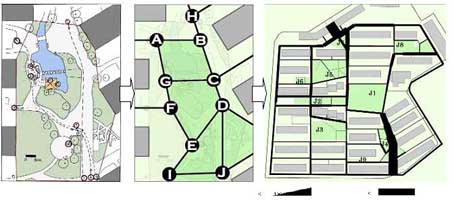 |
 Factors in the appeal of narrow drinking alleys in the heart of Tokyo
Factors in the appeal of narrow drinking alleys in the heart of Tokyo
|
| <International Association for People-Environment Studies, IAPS23 Conference Abstracts, pp. 276-277, Jun. 2014.> |
|
Ryuzo Ohno, Mayuko Yoshida
|
|
In the heart of large Japanese cities we often
find nomiya yokocho, narrow alleys
lined with many small bars and restaurants each with only about 2 meters of
frontage. Most of these neighborhoods arose in the post-World War II recovery period
and still retain much of the rowdier atmosphere of those days. Although redevelopment,
aging wooden buildings, and issues of sanitation have contributed to the disappearance
of many sites, some still do brisk business and even attract foreign tourists.
The present paper seeks to clarify the factors in the appeal of nomiya
yokocho. This question might be approached in terms of three aspects: environmental, behavioral,
and sociocultural. Environmental features include the physical design of the buildings
and other elements, as well as the sounds and smells to be found inside the
alley. The behavioral category has to do with activities such as walking about
the alley or striking up conversations with strangers at a drinking establishment.
Finally, the sociocultural aspect covers such considerations as the image
attached to drinking alleys and the tacit rules governing patron behavior. While all three aspects are closely integrated,
our study focuses mainly on the second (behavioral) and its relationship to the
others.
Our survey site was Omoide Yokocho (“memory
alley”) near Shinjuku station in Tokyo,
which we chose because the interiors of most of its drinking establishments
could be viewed from the alley, albeit to differing degrees. We interviewed
people and observed their activities in three surveys at three different locations:
1) the streets around the alley, 2) in the alley, and 3)inside drinking establishments.To begin we
compared pedestrian traffic density in the alley and the surrounding streets. Pedestrian
traffic was relatively high in the alley, despite its narrow 2-meter width. Interviews
at the alley exit revealed that more than half the people who walk through have
no particular purpose except to take in the atmosphere of the old days. For the
second survey, we observed pedestrian behavior in the alley by extracting
footage from three video cameras for the first 10 minutes of every hour from 5
pm to 12 am, resulting in a total of 3 x 80 minutes’ worth of data. We focused
on one specific behavior, namely the action of looking around while walking;
analysis showed that facade design, in particular the degree of visibility from the alley, influenced pedestrians’ eye
direction. In the third survey, we observed customer activity inside drinking
venues. One interesting characteristic that emerged was the frequency of conversation
among customers who did not know each other, something that is rare in other bars
and restaurants in Japan.
Further investigation suggested this interaction among strangers to be a
consequence of the limited space: for instance, one often needs to ask fellow customers
to give way while weaving through to one’s own seat. Besides this physical factor,
sociocultural considerations such as the attitudes of shop managers and the
presence of local rules were found to affect levels of customer interaction.
|
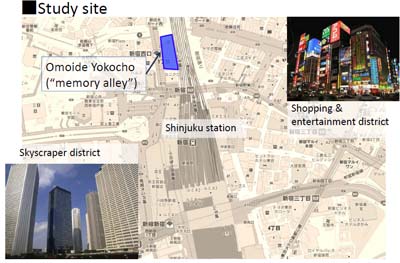
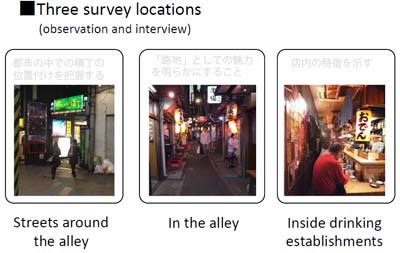 |
|
 A quasi-experiment on a space around a person walking with a trolley bag or baby stroller A quasi-experiment on a space around a person walking with a trolley bag or baby stroller
|
|
<Proceedings of the 44th Annual Conference of Environmental Design Research Association, p. 356, May. 2013.>
Ryuzo Ohno, Izumi Kaneko
|
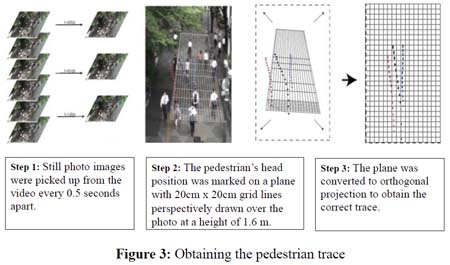 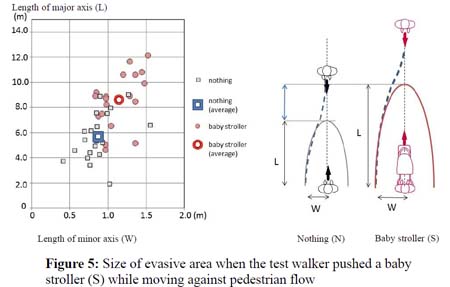 |
|
This study quantitatively examines the behavior of pedestrians moving close to a person with a trolley bag or baby stroller. The data will prove useful in estimating how much extra space needs to be allowed for those with such gear, for example in a railroad station or other transport facility. The experiment was conducted on a crowded street in a Tokyo business district during the morning commute. A male assistant hired for the experiment was asked to walk in three directions with respect to pedestrian flow—1) against, 2) along, and 3) across—while 1) carrying nothing, 2) pushing a baby stroller, 3) pulling a large trolley bag, or 4) pulling a small trolley bag, for a total of 12 experimental situations. The study revealed the following: 1) When moving against pedestrian flow, a walker pushing a baby stroller requires a 53% longer evasive space in the front than while carrying nothing. A 36% and 32% longer space is required for someone pulling a large and small trolley bag, respectively. 2) When moving along with pedestrian flow, a walker pulling a large bag requires a 62% longer evasive space in the back than while carrying nothing. 3) When moving across pedestrian flow, a walker pushing a baby stroller requires a 27% larger evasive space than while carrying nothing. Someone pulling a large or small trolley bag requires an 18% and 20% larger evasive space, respectively.
4) The above data can be used to estimate the extra room that needs to be allowed for people walking with a baby stroller or trolley bag in a public space. 5) A small trolley bag, which many pedestrians often seem not to notice, may carry greater risk of accident.
Paper → EDRA2013(poster)
|
 Seat preference in public squares and distribution of the surrounding people:
Seat preference in public squares and distribution of the surrounding people:
An examination of the validity of using visual simulation |
| <7th EAEA Conference, Dortmund, Germany, 2005> |
|
Ryuzo Ohno, Masashi Soeda, Kondo Yoshihisa, Naoki Hashimoto and Makoto Sato
|
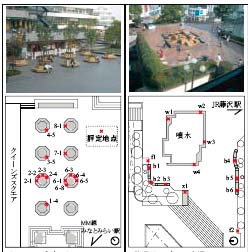
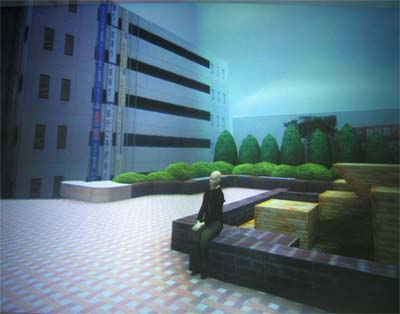 |
When people choose seats in a public square, they unconsciously evaluate not only the physical characteristics of the square but also
the spatial distribution of others already present. This study investigates the classic question of "personal space"—i.e., the spatial component of interpersonal
relations—employing a visual simulation system. The validity of using visual simulation was first examined, following which quantitative relationships
were obtained between subjects’ evaluations of seat positions and such geometrical values as the distance and angle between the seat and others already in the square.
Full paper → PDF file
|
|
 A Study of the Perception of Occupied Area in the Public Space
A Study of the Perception of Occupied Area in the Public Space
|
|
<Journal of Architecture, Planning and Environmental Engineering, No.519,
Pp.93-100, May. 1999>
Ryuzo Ohno, Yoshiharu Matsuda
|
|

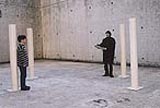
|
People's behavior in a public space is affected by perceived personal
spaces of other people. This study investigated the influence on this perception of the other
people's various positional relationship with such subspace
establishing elements as walls and columns . Full-size experiments demonstrated that there is a
perceived occupied space around a person, depending on the position of that
person in relationship to walls or columns, and that the boundary of this
space is rarely crossed. A second experiment with a scale model of the same
previous spatial arrangements was conducted, as a means of discovering the
extent of these perceived personal space, by the subjects' use of such words
as "aside", "between" and "inside". Thus, the
areas expressed by these words were used to predict the boundary of space that
the subjects rarely go into, i.e. the perceived occupied area.
|
|
 The
Effects of Time-Varying Situations on Behavior in Meeting Places The
Effects of Time-Varying Situations on Behavior in Meeting Places
|
|
<Proceedings of MERA 97: International Conference on Environment-Behavior Studies for 21st Century, Pp.485-490, 1997.11>
Miki Kobayashi, Noriko SEKIMOTO, Ryuzo OHNO
|
|

|
The purpose of this paper is to clarify by objective time-based notation how an environment which changes with time influence behavior. More particularly, this research deals with how behavior in the meeting place is affected by both time and the physical environment. At two popular meeting places in downtown Tokyo, a person's motion was recorded by three TV cameras set in different positions. The movement of each person who answered our interview after rendezvous was studied on the video tape. Items of interview included promised time to meet, description used to specify meeting place, and the experiences of using the place, which we call "initial information". Based on observation of physical arrangements and people's distribution, several contour maps were created to show the level of "local potential" in the meeting place for three basic desires: comfortableness (refuge), easiness to find (prospect), easiness to be found (retreat/reveal). The person's movement trace was overlaid on these maps to describe a series of position choices which reflect varying mental states, or the priority of three basic desires. An analysis of behavior using the notation revealed that, (1)such initial information as specified position and expected direction of approach influence behavior while waiting; (2)different spatial arrangement of the meeting place influences position choice for having good visibility; (3) in crowded situations the desire to be found seem to be growing as time passed. Finally, we proposed implications for the design of meeting places considering temporal, spatial, and psychological factors. |
| Full paper → PDF file |
|
|
 Environment-Behavior System in the Case of Seating in Public Space
Environment-Behavior System in the Case of Seating in Public Space
|
|
<Summaries of Technical Paper of Annual Meeting of Architectural Institute of Japan (D-1), Pp.685- 688, Aug. 1995>
Yasuhiro Abe, Tukasa Hayashi, Ryuzo Ohno
|
|


|
Part1: Quantification and visualization of the environmental
conditions
This study is to clarify the relations between human-behavior and various environmental
conditions, more particularly, it investigated the seating behavior in
public space. A personal computer program which visually shows such quality of an exterior
space as view, pedestrian flow and seat surfaces was created. It was applied
to some urban small parks where a survey investigating seating behavior was conducted.
It is found that people's choice of the place depends on environmental
conditions and the their purpose of visiting the park. |
goto TOP
|